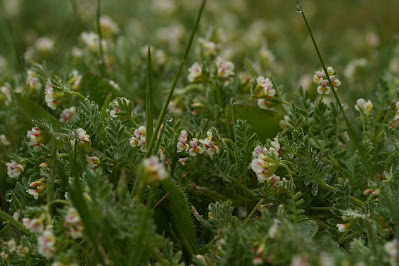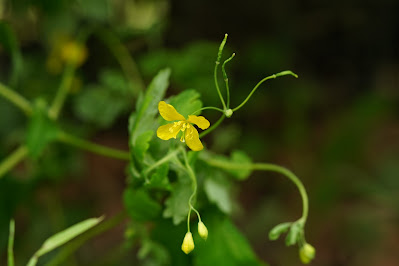Played 18 round the Green yesterday and had a wander round this morning. I'm 80% sure that I saw a Goshawk from the 16th tee soaring over the road. Sadly, by the time I'd dropped the golf club, got my camera out of the golf bag, switched lenses and changed settings it had flown out of site. Despite this disappointment I managed to par the hole after a good up and down from the front bunker.
There are a lot of Dandelion lookalikes around the course at the moment. Here's the real thing. There are actually 232 microspecies of Dandelion - which I have no intention of learning.
 |
| Dandelion Taraxacum officinale [Doghouse range] |
Similar, but slightly paler yellow and with long hairs on its leaves is Mouse-ear Hawkweed. This forms large patches in the rough and I've seen it on the 12th Red and 15th Blue.
 |
| Mouse-ear Hawkweed Hieracium pilosella [15th Blue] |
Catsear is rather taller and fairly common around the courses.
 |
| Catsear Hypochaeris radicata [Doghouse range] |
The rarest is Smooth Catsear which is tiny and found on the Doghouse range. When you go there mid-late morning there are thousands of these tiny yellow flowers, as they open up in the sun. When you go any other time they close up and it is almost impossible to find one.
 |
| Smooth Catsear Hypochaeris glabra [Doghouse range] |
Another that only opens in the morning sun is Goat's-beard. This is about as fully as it opens and there are lots of them on the 15th Blue.
 |
| Goat's-beard Tragopogon pratensis [15th Blue] |
There are also a few different flowers in the potentilla family, particularly around the fen on the 16th Red. Silverweed is the most abundant and it's silvery leaves cover much of the area to the left of the 4th green on the Green.
 |
| Silverweed Potentilla anserina [4th Green] |
Also in the fen is Tormentil, which is smaller and has 4 yellow petals.
 |
| Tormentil Potentilla erecta [4th Green] |
I found this Wild Strawberry earlier in the week whilst looking for my wayward tee-shot on the left of the 18th Blue.
 |
| Wild Strawberry Frageria vesca [18th Blue] |
Growing in drier conditions on the 14th and 15th Red is Common Rock Rose.
 |
| Common Rock Rose Helianthemum nummularium [15th Red] |



















































